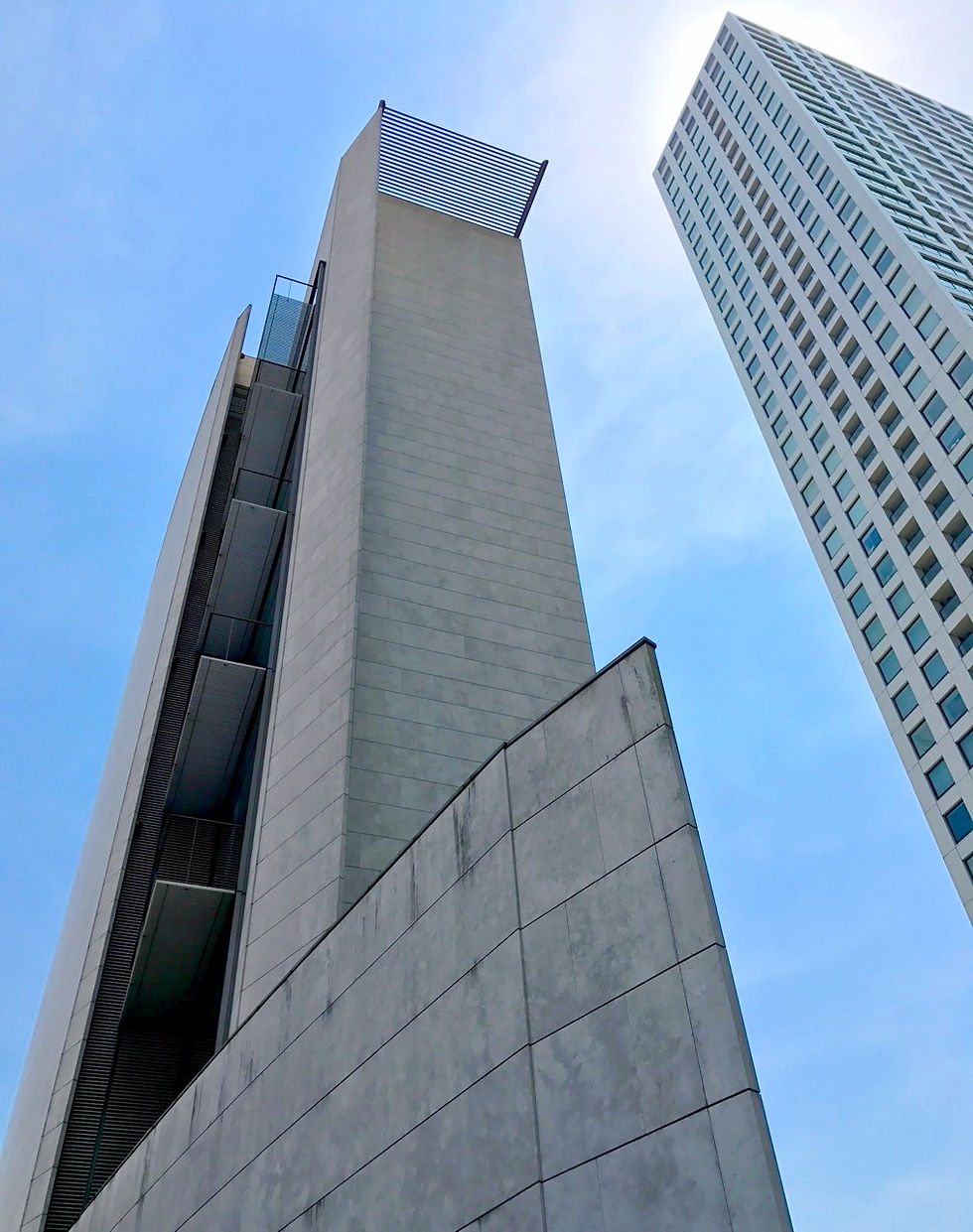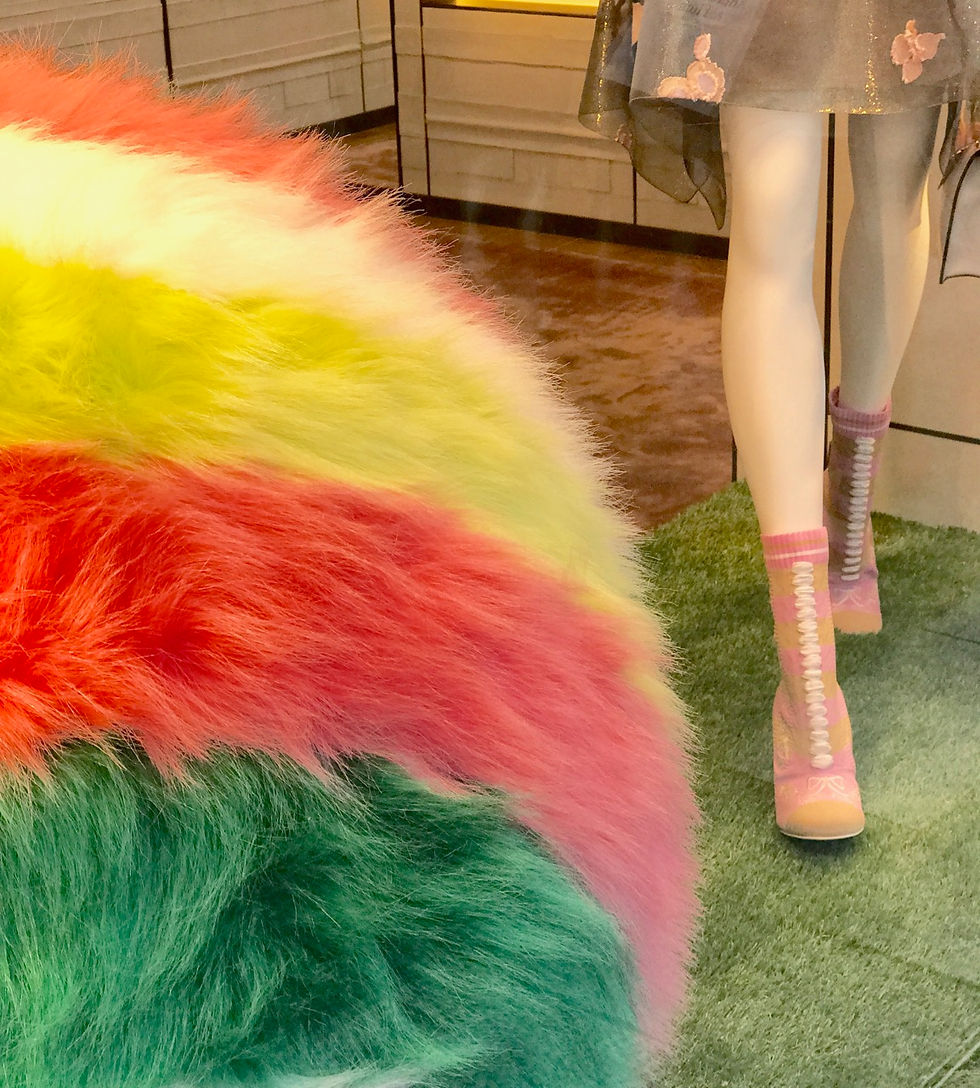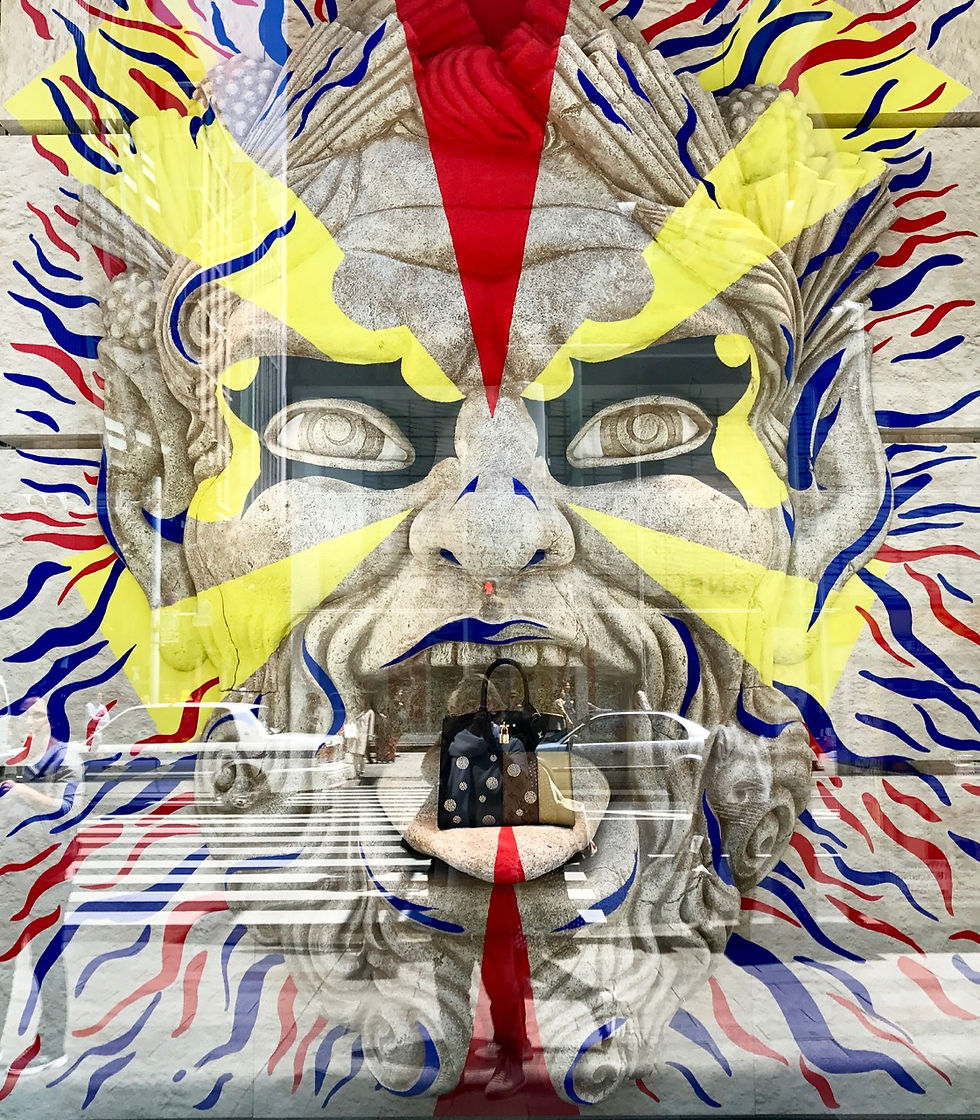20. last day in Tokyo
- Shelley Dark

- Apr 28, 2017
- 9 min read

When we've wanted to say goodbye to shop employees, doormen, wait staff or taxi drivers we've been saying matane rather than sayonara. I found the word on a Japanese app - it sounded the equivalent of au revoir or farewell. We haven't wanted to use the finality of sayonara, which almost seems to be making a judgment: I will NOT be coming back here and I will NOT be seeing you again.
No wonder people have been laughing, because we've discovered that matane is a slang term used between teenage friends, and is as casual as 'see yuh ron (later on)'. I laugh every time I think about our saying it in a formal way, with a bow, to quite proper assistants. But it's always elicited such a joyful response that I'm rather glad we didn't know!

Musée Tomo is a gallery specialising in contemporary ceramics and while John and I were travelling, he found an article in the Japan Times by Tyler Rothmar about the current exhibition.

The founder of Musée Tomo was Madame Tomo Kikuchi who was still running the gallery at the time of her death in 2016 aged 93. You have to take your hat off to Japanese women - many seem to be amazingly dynamic and powerful into old age.
She first had a gallery in Tokyo, then a ceramics boutique in Bloomingdale's New York. Because of her passion for Japanese ceramics she was invited to stage an exhibition of them at both the Smithsonian and the Victoria & Albert Museum in London. Known for her generosity, she had a refined eye and impeccable taste. She put modern Japanese ceramics on the world map.

On family-owned land in Roppongi, she built this tall slender building on the left to house the gallery and offices for the many associated corporations she ran.

I didn't realise that photography is not allowed even at the desk upstairs, so I managed a tiny photo of the stunning sparkling twisted glass railing on the circular staircase down into the basement gallery. It's the work of Yokoyama Naoto whose name is embedded into the glass itself, at the very top.
The gallery rooms beneath have dark crimson and very dark green walls, organza panels stretched tightly from roof to floor as dividers, fixed into a serpentine track in the floor so that the fabric is folded to catch the light. They're an artwork in themselves.
The current exhibition though is not about ceramics. It's the second time the gallery has featured the art of Toko Shinoda. She did the huge pale golden mural panelling you can see covering the circular walls around the staircase above, in 2003, when she was a spring chicken of 90.

This fabulous portrait of her was taken 4 years ago, by Kiyo Fukuda and featured in the Japan Times.
Toko Shinoda turned 104 in March. This exhibition of her work includes some done in 2017.

The Japan Times quotes her as saying: 'I am surprised that I am still here at 104. I never thought that I would live to be this old and to think that I am still able to produce works that delight art lovers is in itself rewarding. I don't paint on any regular schedule, just when the mood strikes me. Sometimes new forms that I had never thought of until recently seem to come to mind and I try my best to put them down as I see them.'
Born into a wealthy family in Manchuria, she was fortunate that her great uncle who had designed a seal for the emperor passed on to her a love of calligraphy. Her work reflects this, although in abstract form.
She uses lithography, and brush and sumi ink. The way sumi appears on the paper depends on many things including humidity, how the ink stick is rubbed on the stone, the equipment. With this art form, there is no going back. The first brush stroke is there forever.

photo courtesy Wikiart: lithograph by Toko Shinada 'Maiden' 1985
She does a little work each day, 'the proof that I am alive'. She is the only Japanese person ever to have had their portrait on a stamp while still living. The painting I loved best was a sumi ink and silver paint on the most superb paper: 'Silence' 2004.
The huge canvas has four or five vertical brush strokes of different widths, overlapping each other to create greys with different depths of colour from transparent to opaque, covering the canvas. Its simplicity was so commanding and yet so delicate. Her current work could have been done by someone in the prime of youth, it's so timeless.
I copied this poem by Tatsuji Muyoshi displayed on the wall. Perhaps it's one of her favourites:
Oh sad, flower petals drift down, onto the young girls flower petals drift down, young girls quietly talking as they walk, the sound of serene footsteps drifting into the sky, occasionally raising their eyes they pass by the springtime in a shadeless temple garden. The tiled roof of the temple has turned green and at each of its eaves the wind bells are hanging silent while being alone I let my own shadow walk over the paving stones.

The old and the new. Since we had to be back at the hotel at 3pm to be at the airport on time, we took a forty minute stroll from the gallery down the hill into Ginza once again.

The chestnuts are coming into flower.

There are some very interesting facades.

A furry ball in Fendi's window.


These two photos were also in Fendi's windows, icing piped onto a tray displaying bags and shoes.

A regal bronze lion and little white Kimba outside Matsuya, arguably the oldest department store in the world. In 1869 Tokube Furuya opened his bespoke tailored kimono shop in Yohohama, and it gradually developed into a major fashion house, employing its first woman in 1906.

By this time, western clothing was in vogue and other branches were opened. In 1926 the practice of making customers remove their shoes before entering the store was abandoned.
The US Military took over the shop as its headquarters in 1946, so trade was severely curtailed. When they left in 1952 it resumed as before. A milestone was reached in 2015 when the first female company director was appointed.

The Ginza 6 designer is quoted as saying that the complex allows its stores to best express their own personalities. I think this restrained facade was Louis Vuitton.

But I think this wild one was LV as well: the handbag on the tongue. It looks more like Versace style doesn't it?

We were interested to see the stationery store G.Itoya, because on the 7th floor there's a hydroponic farm for the caféteria on the 11th. When we walked in the front door, we made a lunch reservation for an hour's time.

On the eleventh floor, through a glass wall we could see lettuce, rocket and Asian greens growing under artificial lighting which emphasised the translucency of the leaves. It all looked so pretty!
Paper samples on one of the 11 floors.
Myriad shelves of card board.

I liked this grey and orange range.

I didn't know Shakespeare wrote that! Isn't it a great quote?

I took this electric image of an in-case-of-fire sign on the shop wall: a red spot above some written instructions. It looked just as fabulous in real life.

We had lunch upstairs in the cafe. From where we sat we could look down into the 'handshake lounge' on the 10th floor. It was closed today. Maybe a businessmen's club?

We both had healthy organic salads, but with a small addition. Chips and lime aioli. It's been a while! Can you blame us?



This darling girl looked after us at lunch. When I asked her if I may take her photo, she was so amused by the idea that she couldn't stop laughing.
you can click on any gallery like the one above to bring up a slide show - they're worth a closer look!
We arrived back at the hotel just on 3pm. These people in costume were coming out of the front door like actors on their way to work. When I asked if I could take their photo, we thought they were saying that they must go, because they trooped around the corner of the building.
The doorman indicated that we should follow, that they were going around the corner to oblige! We followed and they posed with rather inscrutable expressions. Maybe they were in a sad play? The little boy was very suspicious, but just after the first photo he burst into a smile and turned his face away to hide it. His father smiled too.
After they had left, I asked the doorman what venue they were performing in. No, he smiled. No, they're not performers, they're just people who like dressing up! No wonder they were inscrutable! What good sports!
We called in briefly to see the kintsugi plates used in the hotel's Japanese restaurant.

And said goodbye to our favourite breakfast waitress. My best friend on the left.

I still have to tell you about last night's dinner. Chef Yoshihiro Narisawa was born in Japan and trained in Switzerland, Italy and in France under Joël Robuchon. It's a friendly small restaurant and the cuisine is Japanese French fusion. The photo above shows the discreet signage outside.

The first couple of courses were served on this thick glass plate - the etched name underneath is magically reflected on the edge.

The sakura theme for the evening started with these baby fish in a sakura jelly. Ange exclaimed, Oh they're so cute. The waiter replied with a straight face, yes, that's why we use them. Twinkling eyes. Thibauld was French, and fun.

The sakura-decorated black serving trolley looked so attractive. The decor is elegant, modern, even austere - white walls with black wood panelling and wide black floor boards thick with transparent layers of lacquer-style polish. Stiffly starched white cloths and napkins. The food does the talking.

We started with chips from the Chinese takeaway! -:) Aren't the colours and reflections pretty? For each course, the restaurant manager explained the ingredients and the references to Satoyama cuisine.
Satoyama is a Japanese term which means a mosaic of different ecosystems: forests, agricultural land, irrigation ponds, ocean and human settlements. All must live in harmony. The food at Narisawa is drawn from all, but only to a sustainable extent.

Loved my one Hiroshima oyster and green caviar (peas!)

Ange had this pea and asparagus instead.

The bread rolls were cooked at the far corner of our square table: first proofed in a glass and then baked in a very hot pottery container with a hot slate lid for twenty minutes. Do not touch, said Thibauld. The butter was covered in a forest moss of crushed herbs.

This tile fish was caught in the Sea of Japan, with pink sakura sauce and green sauce made from that sansho pepper I loved in Kyoto. We also ate a leaf of it - hope we can buy the plant here.

This was shrimp with sakura sauce frozen in liquid nitrogen and ladled on to the plate in solid form. The vapours drifted off the plate.

A teeny piece of Shimane beef which looked and tasted more like grass-fed than the heavily lot-fed wagyu we've been having. It had been rolled in powdered burnt leek.

Finest handmade steak knives: this is the join between wood and the wavy lines of the hand forged steel.

Dessert of a sakura rice ball. The whole meal was a visual delight. There were a couple of other courses I forgot to photograph.

The kitchen, visible from the dining area, was a study is total control. No rushing, no noise. Chef Narisawa came out to say hi.

It was such a happy evening for our last dinner in Japan. What a wonderful way to end our journey together. Hai!

I'll be putting together a comprehensive list for Japan, which I'll post for you next week. Japan planning, booking, the hotels, an update on packing, handy hints. I'd also like to think more about the Japanese aesthetic and how it's been reflected in the experience we have had together.
And of course I have to start planning for Africa in August. I hope you will come! I'll let you know when I put it in the the shop.

I'd like to thank you again for your trust in me. Each time you travel with me, I'm deeply conscious of the faith you are showing to buy a product which has not even been written.
I love travelling with you and for you, and I adore writing and editing the photos at night, even more with Ange on board! And I'm so grateful to John for his never-failing support, to Ange for her company and help(less laughter), and to Ange's husband Philippe and her two children for doing without her for a week - thank goodness for Facetime!
My whole travel experience is so far improved by having all of you to share it with, that I don't want to travel without you!

The doorman is waving goodbye with the koala memento we gave him. Matane!

the almost ethereal beauty of the little fairy iris which we've seen in drifts everywhere - John's photo
Until next time, it's definitely not sayonara. I will always wait you.




























































